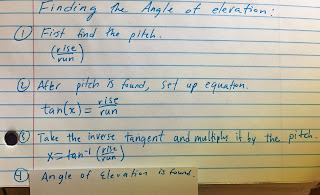Trig: The Pitch of a Roof

When developers are constructing houses, they must account for the roof. When constructing these roofs, the word pitch is used to assess the incline. The term "pitch" is another type of measurement that is expressed when using slope. Like grade, it determines the steepness of a slope, but instead of measuring roads, pitch measures the steepness of roofs. Like grade and slope, to determining pitch is quite simple. You take the rise over run. When finding the angle of elevation of a roof when given its pitch, you simply take the inverse tangent and multiply it by the pitch. For example, a terracotta roof vertically "rises" 11 inches for every 18 inches horizontally "run". This means the pitch of the roof would be 11/18. What would the angle of elevation of the roof be? To solve this problem and find the angle of elevation, you simply take the inverse tangent and multiply it by the pitch. If following steps above, you should get the answer...
